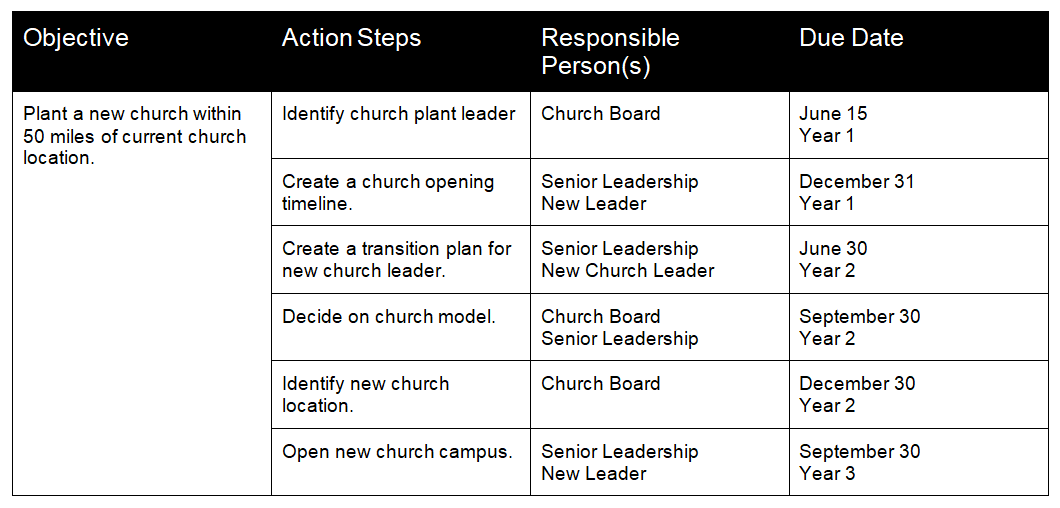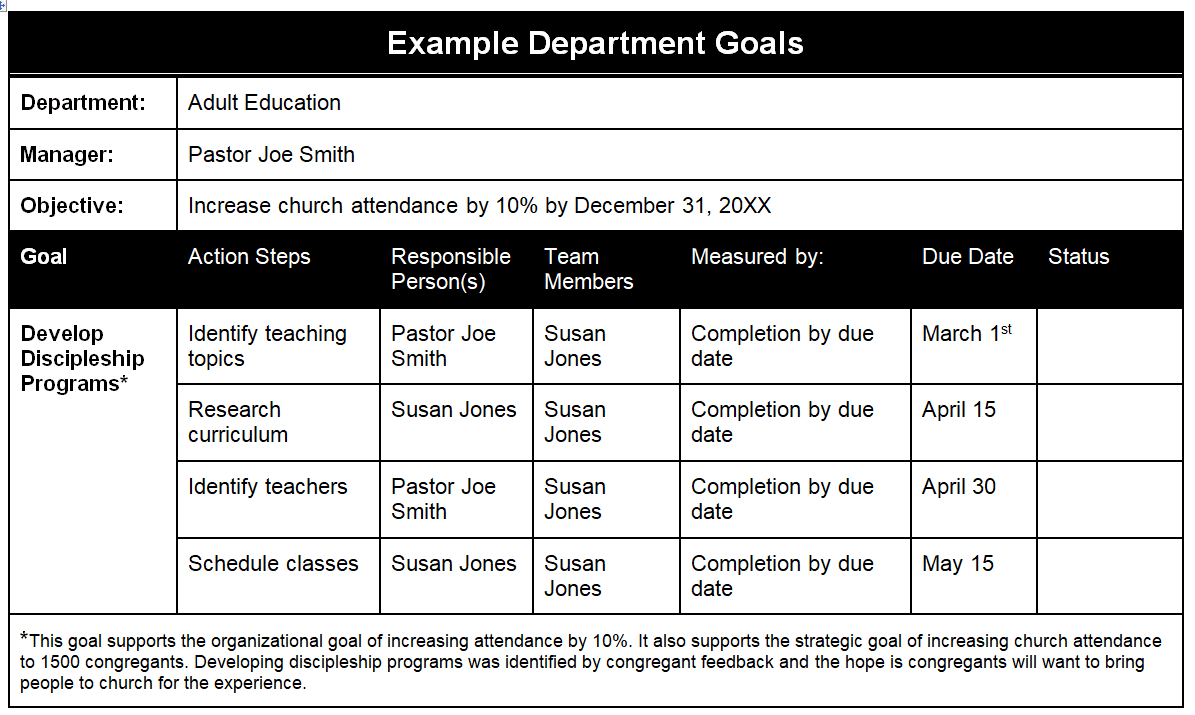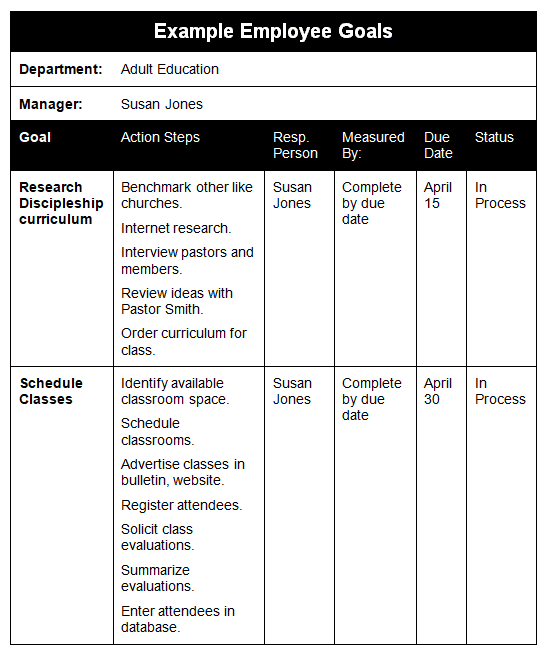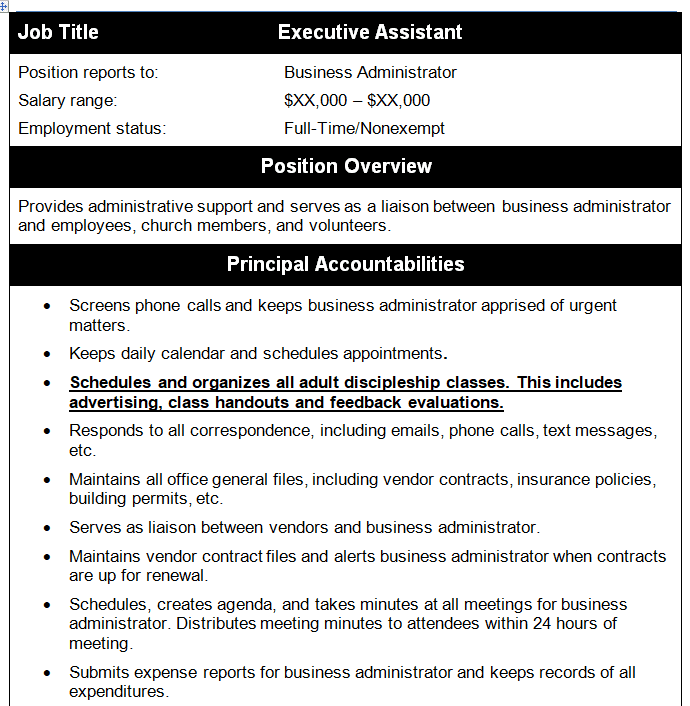Estimated reading time: 10 minutes
Churches serve an important purpose. That purpose is to help people find their place in the body of Christ and to translate the events of this chaotic world through Biblical principles.
This purpose is why a church exists – its mission.
In order for a church to fulfill its mission (why it exists) it must take the time to develop a strategy, plan the steps to get it done, and manage the process. Implementing church strategy takes focus!
To manage the process, you will need to identify who needs to do what, by when, and hold them accountable for what they are responsible for doing.
This step is done through a strategic planning process.
A strategic plan is only as effective as the goals that are written to implement it.
And, goals are only as effective as the people who are responsible for completing them. It is the leadership’s responsibility to make sure it gets done.
7 Steps to Implementing Church Strategy
1. Vision, Mission, and Values
The first step is to write a church vision, mission, and values statement.
This step is important because it clarifies why the ministry exists (mission) and what it is trying to accomplish (vision).
It also articulates the guiding principles (values) by which it operates and makes decisions.
This is arguably the most important step because it sets the direction for the church and creates a structure for decision-making.
Clarity of vision, helps your church stay the course.
2. Strategic Plan
After the vision, mission, and values are written, a church strategic plan can be developed. This strategy plan simply maps out the necessary steps to achieve the ministry’s mission and vision.
A strategic plan can be both short-term (3-6 months) or long-term (1-3 years), or a combination of both.
There was a time when strategic plans went as far out as five or ten years, but because of rapidly changing conditions, shorter-term plans seem to be more common.
The first step is to identify the outcome – what it is you want to accomplish in three years.

Take some time to brainstorm or visualize what that future state looks like. This will be the beginning of the plan.
For example, strategic objectives or outcomes might be things like building a bible school, planting churches, sending missionaries to certain parts of the world, or developing worship leaders – whatever supports the church’s vision.
Next, create a timeline for the completion of objectives and determine how many weeks, months, or years it will realistically take to complete the objectives.
This is done by thinking through the high-level action steps needed to complete the tasks involved.
Example 3-Year Church Strategic Plan

Once you’ve identified what it is you want to accomplish (this should line up with the mission/vision), the next step is to start mapping out what it will take to get there.
For example, to plant a church, you need to ask the question, what are the steps that need to be taken? – ie: identify church plant leader, identify new church location, decide on church model, a transition plan for the leader, timeline for the new church opening, etc.
This detailed planning can be put in the format of an action plan.
An action plan is merely a written document outlining the objectives (goals), action steps, responsible person(s), possible team members, the due date for each action step, and implementation status.
Mapping this out creates a visual that is easy to see at a glance for what needs to be done, by whom, and by when.
Example Action Plan For Strategic Objective

As you create the action plan document, you will identify objectives or steps that individual church departments need to take to support this strategic objective.
And, as each department identifies its goals and objectives, it provides the information needed to write individual (or volunteer) job descriptions and goals, which support departmental goals, which support organizational goals, and ultimately the strategic plan.
When goals and objectives are written to have a straight-line influence on the strategic plan it helps to achieve the long-term goals of the organization.
3. Organizational Goals
Goals are important because they provide direction, clarify job roles, give something to strive for, show how far you’ve come, and help make the vision attainable.
Having goals written down makes it more real and achievable. It also allows you to see where you are going and the steps to get there.
Church goals should be written at the organizational level as the first step in strategic implementation.
This involves high-level goals that the church as a whole is trying to accomplish.
These high-level goals are typically what a Business Administrator is accountable for to the board or governing body.
As the organization works toward accomplishing the strategic plan, there needs to be a structured process to take the organization from where it is to where it wants to be.
This can be done by developing annual organizational goals that are written to break the long-term goals into bite-sized pieces.
This step also provides the framework to accomplish them in steps and stages, rather than the overwhelming task of trying to do them all at once, and a tool to monitor their progress.
This is done by spreading the responsibility of the goals to the departmental and staff level.
This step helps to ensure that what staff is doing day-to-day lines up with the vision and goals of the organization, and keeps employees focused on church priorities.
The structured process should include a cycle that begins with writing goals, communicating expectations, monitoring performance toward goals, assessing performance, and lastly, ending with the performance appraisal.
This cycle is repeated annually.
Once the organization has some direction for what it wants to accomplish during the next twelve months, the priorities can be shared at the department level.
This step ensures that there is a person or group of people with responsibility for completing those goals.
Example Year 1 Annual Church Goals
- Increase weekly attendance by 10% (120 people based on 1200 member church). This supports the strategic objective of growing the church to 1500 people in three years.
- Increase the number of church volunteers by 20% (50 new volunteers based on 250 current volunteers). This supports the strategic objective of growing the volunteer base by 20%, from 250 – 350 volunteers.
- Decrease operating expenses by 5%. This supports the strategic objective of reducing operating expenses by 5%.
4. Departmental Goals
Once there are defined church goals, goals should then be delegated to the respective ministry heads or department managers.
This is where the chain of command or organizational structure delegates responsibilities for completing goals.
For example, a Business Administrator may have a responsibility to achieve goals at the organizational level but may use the help of a ministry head or volunteer to accomplish those goals.
The ministry head or volunteer may then use employees or volunteers to help achieve goals. Now, you take these Church (organizational) annual goals and break them down at the department level.
This requires assigning the goal to a specific department.
For example, the church’s goal of increasing weekly attendance by 10% can be delegated to several different departments, but one specific department might be adult education.
This is an example of what that departmental goal might look like:

5. Employee Goals
To ensure that the departmental goals are accomplished, they need to be driven down to the individual employee/volunteer level.
This is done by identifying the steps the employee needs to take in order to accomplish the goals.
As you will note, these goals line up with the individual’s departmental goals.
This goal document is a valuable tool during the annual performance appraisal process because it helps to ensure that what the organization wanted to accomplish at the beginning of the year was completed.
Departmental goals should be delegated to employees within the department to share the responsibility for getting things done.
Some churches don’t have employees but may use volunteers to help accomplish goals.
The more people who help and have accountability for achieving goals, the more achievable the implementation becomes.
Now, we will take the above departmental goal and break it down into steps for an employee or volunteer to accomplish.

As you will notice, the objective (goal) for Susan is taken from the action steps in the departmental goal.
This allows Pastor Joe Smith to assign responsibility to Susan Jones for accomplishing this goal.
This document will be used when Susan is reviewed at her annual performance appraisal, which will demonstrate the completion of her goal.
When Susan completes her goal, it allows Pastor Joe Smith to accomplish his goals – which supports the overall church goals.
6. Job Description
A church employee’s or volunteer’s job description should include their goal responsibilities and be updated annually.
This helps to ensure that the job description is accurate.
Job descriptions should be written to reflect individual goals that support the departmental goals as well as reporting relationships (this is to identify who the boss is).
The document should also list job duties that this person is responsible for.
Job descriptions should be reviewed and updated annually (performance appraisal time is a good time to do this).
Example Church Staff Job Description

As you can see, the responsibility of organizing adult discipleship classes is in the administrative assistant’s job duties description.
This provides a direct link between staff members’ job duties, their department goals, and, ultimately, the global goals that support the strategic plan.
7. Performance Appraisals
The performance appraisal process should be a time to reflect on the last year and celebrate successes.
It should also be used as a time to course-correct if an employee has gotten off track.
Reinforcing the positive and celebrating the successes can influence future positive behaviors.
A structured performance management process incorporates annual goals into the employee performance appraisal and holds employees accountable for completing those goals that support church strategy.
Churches that invest the time in clarifying their mission and vision and develop a strategic plan that disseminates goals throughout the ministry not only experience success at implementing the plan but also engage employees and volunteers to support the mission of the organization.
This kind of engagement is how God uses the body to build the church!
Access editable copies of these planning documents in our expanding library of forms and job descriptions. If you are already a member, click here to access the forms.
If you are not a member and would like to learn more click here.



